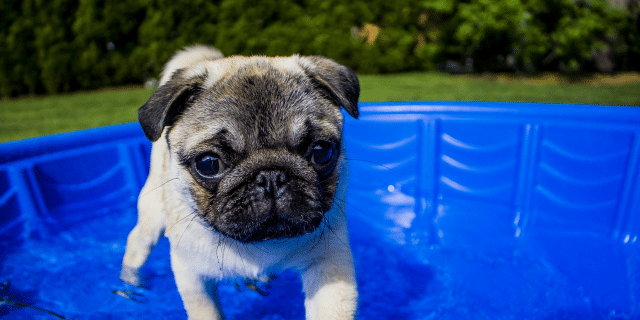Summer is here, and our four-legged friends are ready to make the most of it—soaking up the sun, chasing butterflies, and joining us for backyard barbecues and beach days. But while the season is packed with tail-wagging fun, it also brings a few hidden hazards that can sneak up on even the most watchful pet parents. From sizzling sidewalks to tempting picnic snacks, summertime can be trickier than it looks. Here’s how to keep your fur babies safe, healthy, and ready for all the warm-weather adventures ahead!
Barbecues, Picnics, and Parties
Nothing says summer like a backyard cookout—but it’s not always a pet-friendly affair. Popular BBQ foods like rib bones, corn on the cob, and watermelon rinds may seem harmless but can cause serious health issues, including choking and intestinal blockages. Onions, grapes, and alcohol are outright toxic to pets, and treats like ice cream and potato salad can upset sensitive stomachs. Also be mindful of wooden skewers and toothpicks, which can splinter and cause internal injuries if chewed or swallowed.
Remind your guests not to share their food with your pet. Instead offer pet-safe treats as an alternative. Supervise your furry friend closely, especially if they’re known for getting into mischief—or are particularly sociable.
Lawn and Pool Chemicals
Beautiful lawns and sparkling pools can hide serious dangers. Fertilizers, pesticides, and pool chemicals are harmful if ingested, inhaled, or absorbed through your pet’s paws. Always store chemicals securely, clean up spills right away, and keep pets off freshly treated grass. When possible, choose pet-safe products that reduce the risk while still maintaining your outdoor space.
Dangerous Plants
Gardening this summer? Be sure your landscaping isn’t a hidden health hazard. Azaleas, lilies, rhododendrons, tulips, and daffodils are just a few of the plants that can be toxic to pets. Ingesting them can lead to vomiting, seizures, heart issues, and even death. Before heading out on a walk or letting your pet explore the garden, brush up on which plants are safe. (Check out our pets and plants blog for a detailed guide.)
Itchy and Stinging Insects
Summer means bugs—and lots of them. Fleas, ticks, and mosquitos can make your pet miserable and may carry dangerous diseases like heartworm and Lyme disease. Bees, wasps, and fire ants also pose risks, especially to curious pets who like to sniff and paw at anything that moves.
To protect your pet:
- Use flea, tick, and heartworm preventatives
- Check daily for ticks, especially after walks in wooded or grassy areas.
- Eliminate standing water and trim overgrown plants to deter pests.
- Monitor your pet for signs of bites or stings, such as swelling, excessive scratching, or difficulty breathing. In the case of a severe allergic reaction, seek veterinary help immediately.
Heat and Humidity
High temperatures and humidity can quickly lead to heat exhaustion or heatstroke, especially for older pets, overweight pets, or breeds with short snouts like pugs and bulldogs. Signs of heatstroke include excessive panting, drooling, and dry gums (a sign of dehydration). Your pet also may appear lethargic.
Always provide shade and fresh water and avoid intense activity during the hottest parts of the day. Never leave your pet in a parked car—not even for a few minutes. On a 75-degree day, the temperature inside a vehicle can soar to 100 degrees in just 30 minutes.
Also, be cautious of hot pavement and sand. Use the hand test: place your hand on the sidewalk for seven seconds. If it’s too hot for your hand, it’s too hot for paws. And don’t forget about sunburn! Pets can get burned too—especially on ears, noses, and bellies. Use pet-safe sunscreen, never human sunscreen, to protect exposed areas.
The Beach and the Pool
Many dogs love the beach, but it can come with unexpected dangers. Hot sand can burn sensitive paw pads, and ingesting sand can lead to a dangerous bowel obstruction. Sand can also irritate your pet’s eyes if it gets lodged under their eyelids.
As for water safety, not all dogs are natural swimmers. Never force your pet into the water, and always use a pet lifejacket, especially if you’re on a boat or near deep water. After a swim, rinse your dog off to remove salt or chlorine.
Fireworks and Thunderstorms
The loud booms of summer storms and fireworks can terrify pets, causing stress, anxiety, or even escape attempts. Prepare a safe, quiet space indoors where your pet can retreat. You can also try anxiety wraps, pet pheromone sprays, and soft music or white noise. For severe anxiety, talk to your vet about possible calming medications. And always secure doors, gates, and windows in case your pet tries to bolt.
Traveling with Your Pet
Planning a road trip with your fur baby? Keep your pet secured in a well-ventilated carrier or use a pet seatbelt harness. Never leave them unattended in a parked vehicle. Bring along water, treats, and poop bags, and schedule regular breaks.
Make sure your pet is microchipped and wearing ID tags with up-to-date contact info—just in case you get separated. If you’re flying, be sure to review your airline’s pet policy or check out our blog on flying with pets for extra tips.
One More Layer of Protection
We love our pets and no matter how careful we are, accidents happen. Pet insurance can offer peace of mind, helping cover unexpected vet bills so you can focus on keeping your pet happy and healthy all summer long.
This article is furnished by California Casualty, providing auto and home insurance to educators, law enforcement officers, firefighters, and nurses. Get a quote at 1.866.704.8614 or www.calcas.com.
- Tires 101: Rotation, Alignment and Balancing Explained - December 22, 2025
- Holiday Fire Safety Tips - December 16, 2025
- Party Potluck Recipes - December 11, 2025

